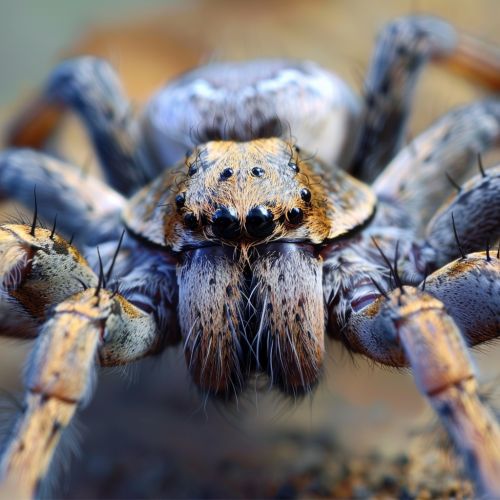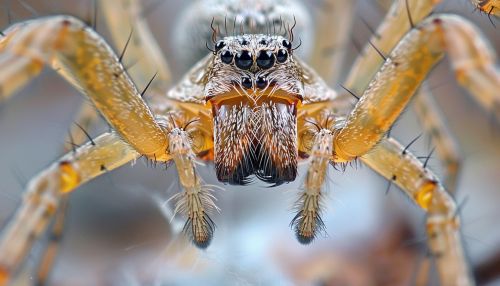Chelicerata
Introduction
Chelicerata is a subphylum of the phylum Arthropoda, encompassing a diverse group of arthropods that include spiders, scorpions, ticks, mites, and horseshoe crabs. This subphylum is characterized by the presence of chelicerae, which are specialized mouthparts used for feeding. Chelicerates are primarily terrestrial, although some species are aquatic. They play significant roles in various ecosystems, acting as predators, parasites, and scavengers.
Morphology
Chelicerates exhibit a wide range of morphological adaptations that have allowed them to colonize diverse habitats. The body of a chelicerate is divided into two main regions: the prosoma (or cephalothorax) and the opisthosoma (or abdomen). The prosoma typically bears six pairs of appendages: one pair of chelicerae, one pair of pedipalps, and four pairs of walking legs.
Prosoma
The prosoma is the anterior part of the body and is covered by a hard exoskeleton. The chelicerae are the first pair of appendages and are often modified into fangs or pincers for capturing and subduing prey. The pedipalps, which are the second pair of appendages, can be modified for various functions, including sensory perception, feeding, and reproduction.


Opisthosoma
The opisthosoma, or abdomen, contains the digestive, reproductive, excretory, and respiratory systems. In some chelicerates, such as spiders, the opisthosoma is connected to the prosoma by a narrow pedicel, allowing greater flexibility. The respiratory system may include book lungs or tracheae, depending on the species.
Classification
Chelicerata is divided into several classes, the most notable of which are:
Arachnida
The class Arachnida includes spiders, scorpions, ticks, and mites. Arachnids are predominantly terrestrial and are characterized by their eight legs and lack of antennae. Spiders possess silk-producing glands and are known for their web-building behavior, while scorpions are recognized for their venomous stingers.
Merostomata
The class Merostomata includes horseshoe crabs, which are ancient marine arthropods. Horseshoe crabs have a hard, dome-shaped carapace and a long, pointed telson. They are known for their blue blood, which contains a substance used in medical testing.
Pycnogonida
The class Pycnogonida, or sea spiders, are marine chelicerates with long legs and a small body. They are found in various oceanic environments, from shallow waters to deep-sea trenches. Sea spiders have a unique feeding mechanism, using their proboscis to suck nutrients from soft-bodied invertebrates.
Physiology
Chelicerates exhibit a range of physiological adaptations that enable them to thrive in various environments. Their exoskeleton provides protection and support, while their jointed appendages allow for efficient locomotion.
Respiratory System
The respiratory system of chelicerates varies among different groups. Spiders and scorpions possess book lungs, which are stacked, leaf-like structures that facilitate gas exchange. Other chelicerates, such as mites and ticks, use tracheae, which are networks of tubes that deliver oxygen directly to tissues.
Circulatory System
Chelicerates have an open circulatory system, where hemolymph (the equivalent of blood) circulates through the body cavity. The heart pumps hemolymph through arteries, which then bathes the internal organs before returning to the heart.
Nervous System
The nervous system of chelicerates consists of a dorsal brain and a ventral nerve cord. Sensory organs, such as compound eyes and mechanoreceptors, allow chelicerates to detect environmental stimuli. Spiders, for example, have multiple eyes that provide them with a wide field of vision.
Ecology
Chelicerates occupy various ecological niches and play crucial roles in their respective ecosystems. They can be predators, parasites, scavengers, or herbivores, depending on the species.
Predation
Many chelicerates, such as spiders and scorpions, are predators that hunt and capture prey. Spiders use their silk to build webs that trap insects, while scorpions use their pincers and venomous stingers to subdue prey.
Parasitism
Ticks and mites are notable for their parasitic lifestyles. Ticks are ectoparasites that feed on the blood of vertebrates, including humans, and can transmit diseases such as Lyme disease. Mites can be parasitic or free-living and are found in various habitats, from soil to human skin.
Scavenging
Some chelicerates, such as certain species of mites, are scavengers that feed on decaying organic matter. This behavior helps in nutrient recycling and decomposition processes in ecosystems.
Reproduction
Reproductive strategies among chelicerates vary widely. Most chelicerates have separate sexes, although some species exhibit hermaphroditism.
Mating Behavior
Mating behavior in chelicerates can be complex and involves various courtship rituals. For example, male spiders often perform elaborate dances or offer nuptial gifts to females to avoid being eaten during mating. Scorpions engage in a "promenade à deux," where the male and female grasp each other's pedipalps and perform a coordinated dance.
Egg Laying and Development
Chelicerates typically lay eggs, which can be deposited in various environments depending on the species. Spider eggs are often enclosed in silk egg sacs, while scorpions give birth to live young. The development of chelicerates can involve multiple molts, where the exoskeleton is shed to allow for growth.
Evolutionary History
The evolutionary history of Chelicerata dates back to the Cambrian period, over 500 million years ago. Fossil evidence suggests that early chelicerates were marine organisms, with terrestrial forms evolving later.
Fossil Record
The fossil record of chelicerates includes well-preserved specimens of ancient sea scorpions (eurypterids) and early arachnids. Horseshoe crabs, which have remained relatively unchanged for millions of years, are often referred to as "living fossils."
Phylogenetic Relationships
Phylogenetic studies have provided insights into the evolutionary relationships among chelicerates. Molecular data suggest that arachnids are more closely related to horseshoe crabs than previously thought, challenging traditional classifications.
Importance to Humans
Chelicerates have significant impacts on human activities, both positive and negative.
Medical Importance
Some chelicerates, such as ticks and mites, are vectors of diseases that affect humans and animals. Lyme disease, transmitted by the Ixodes tick, is a notable example. Additionally, the venom of certain spiders and scorpions can pose health risks.
Agricultural Impact
Chelicerates can also affect agriculture. Mites, for example, can be pests that damage crops and stored products. Conversely, some chelicerates, such as predatory mites, are used in biological control programs to manage pest populations.
Scientific Research
Chelicerates are valuable models in scientific research. The blue blood of horseshoe crabs contains Limulus amebocyte lysate, which is used to detect bacterial endotoxins in medical applications. Spiders' silk has inspired the development of new materials due to its strength and elasticity.
Conservation
The conservation status of chelicerates varies among species. Habitat loss, climate change, and human activities pose threats to certain chelicerate populations.
Threatened Species
Some chelicerates, such as certain species of spiders and scorpions, are listed as threatened or endangered due to habitat destruction and over-collection. Conservation efforts aim to protect these species and their habitats.
Conservation Programs
Various conservation programs focus on preserving chelicerate diversity. These programs include habitat restoration, captive breeding, and public education initiatives to raise awareness about the ecological importance of chelicerates.
